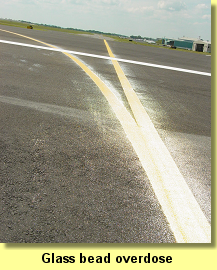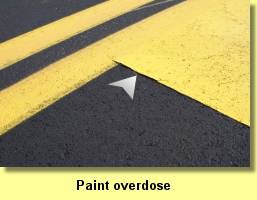|
Back to Webletter

Would you take more than the recommended dosage of a medicine than prescribed by your doctor? Well, I hope the answer
to that question is "Probably not"! It is important to your well being to follow the physician's orders. The same holds true for
pavement marking materials, as they can be prone to over medicating.
 Pavement marking is a relatively simple science; however there are common misconceptions and pitfalls Sightline sees
occurring at several client sites. I witness people using more glass beads, thinking they will achieve a brighter line. This practice
is far from the truth. Actually, brightness often decreases as a result of overpopulation which compromises visibility, not to mention
you can also subject yourself to a huge housecleaning (liability) issue as seen in the picture to the right.
Pavement marking is a relatively simple science; however there are common misconceptions and pitfalls Sightline sees
occurring at several client sites. I witness people using more glass beads, thinking they will achieve a brighter line. This practice
is far from the truth. Actually, brightness often decreases as a result of overpopulation which compromises visibility, not to mention
you can also subject yourself to a huge housecleaning (liability) issue as seen in the picture to the right.
Light travels through each bead to reach the paint, bends, and returns to the source from which it came. If stacks of
beads are on the surface, the light must travel through many beads to hit substrate and must then return through multiple layers of
glass, diluting its intensity. Initial retroreflectivity is low when too many beads are applied. Eventually, as the marking wears,
excess beads dislodge, and reflectivity values increase.
 The same is true for paint, especially on new asphalt. I recently visited an airport where a contractor applied shoulder
markings by hand. The application resulted in an uncontrolled thickness of paint, much greater than specified, which caused the markings
to severely crack. The cracking was so bad in some areas, it was pulling up the NEW asphalt, pictured, left. Removal, by grinding,
was the prescribed remedy, followed by replacement. This compromises the new asphalt overlay by imposing unnecessary added stress to the
pavement. Much of this could have been avoided had Sightline been there to inspect installation practices. Not only was this an expensive
mistake but also it was also quite an embarrassment to all parties involved.
The same is true for paint, especially on new asphalt. I recently visited an airport where a contractor applied shoulder
markings by hand. The application resulted in an uncontrolled thickness of paint, much greater than specified, which caused the markings
to severely crack. The cracking was so bad in some areas, it was pulling up the NEW asphalt, pictured, left. Removal, by grinding,
was the prescribed remedy, followed by replacement. This compromises the new asphalt overlay by imposing unnecessary added stress to the
pavement. Much of this could have been avoided had Sightline been there to inspect installation practices. Not only was this an expensive
mistake but also it was also quite an embarrassment to all parties involved.
Tools are available to monitor glass bead application rates and wet film thickness during installation. Too much of either
component in the airfield marking system can actually be detrimental to the performance. I see a lot of overdosing going on when it comes
to applying materials on a project; the outcome is not healthy for the aviation community.
Back to Webletter
|




 Pavement marking is a relatively simple science; however there are common misconceptions and pitfalls Sightline sees
occurring at several client sites. I witness people using more glass beads, thinking they will achieve a brighter line. This practice
is far from the truth. Actually, brightness often decreases as a result of overpopulation which compromises visibility, not to mention
you can also subject yourself to a huge housecleaning (liability) issue as seen in the picture to the right.
Pavement marking is a relatively simple science; however there are common misconceptions and pitfalls Sightline sees
occurring at several client sites. I witness people using more glass beads, thinking they will achieve a brighter line. This practice
is far from the truth. Actually, brightness often decreases as a result of overpopulation which compromises visibility, not to mention
you can also subject yourself to a huge housecleaning (liability) issue as seen in the picture to the right.
 The same is true for paint, especially on new asphalt. I recently visited an airport where a contractor applied shoulder
markings by hand. The application resulted in an uncontrolled thickness of paint, much greater than specified, which caused the markings
to severely crack. The cracking was so bad in some areas, it was pulling up the NEW asphalt, pictured, left. Removal, by grinding,
was the prescribed remedy, followed by replacement. This compromises the new asphalt overlay by imposing unnecessary added stress to the
pavement. Much of this could have been avoided had Sightline been there to inspect installation practices. Not only was this an expensive
mistake but also it was also quite an embarrassment to all parties involved.
The same is true for paint, especially on new asphalt. I recently visited an airport where a contractor applied shoulder
markings by hand. The application resulted in an uncontrolled thickness of paint, much greater than specified, which caused the markings
to severely crack. The cracking was so bad in some areas, it was pulling up the NEW asphalt, pictured, left. Removal, by grinding,
was the prescribed remedy, followed by replacement. This compromises the new asphalt overlay by imposing unnecessary added stress to the
pavement. Much of this could have been avoided had Sightline been there to inspect installation practices. Not only was this an expensive
mistake but also it was also quite an embarrassment to all parties involved.